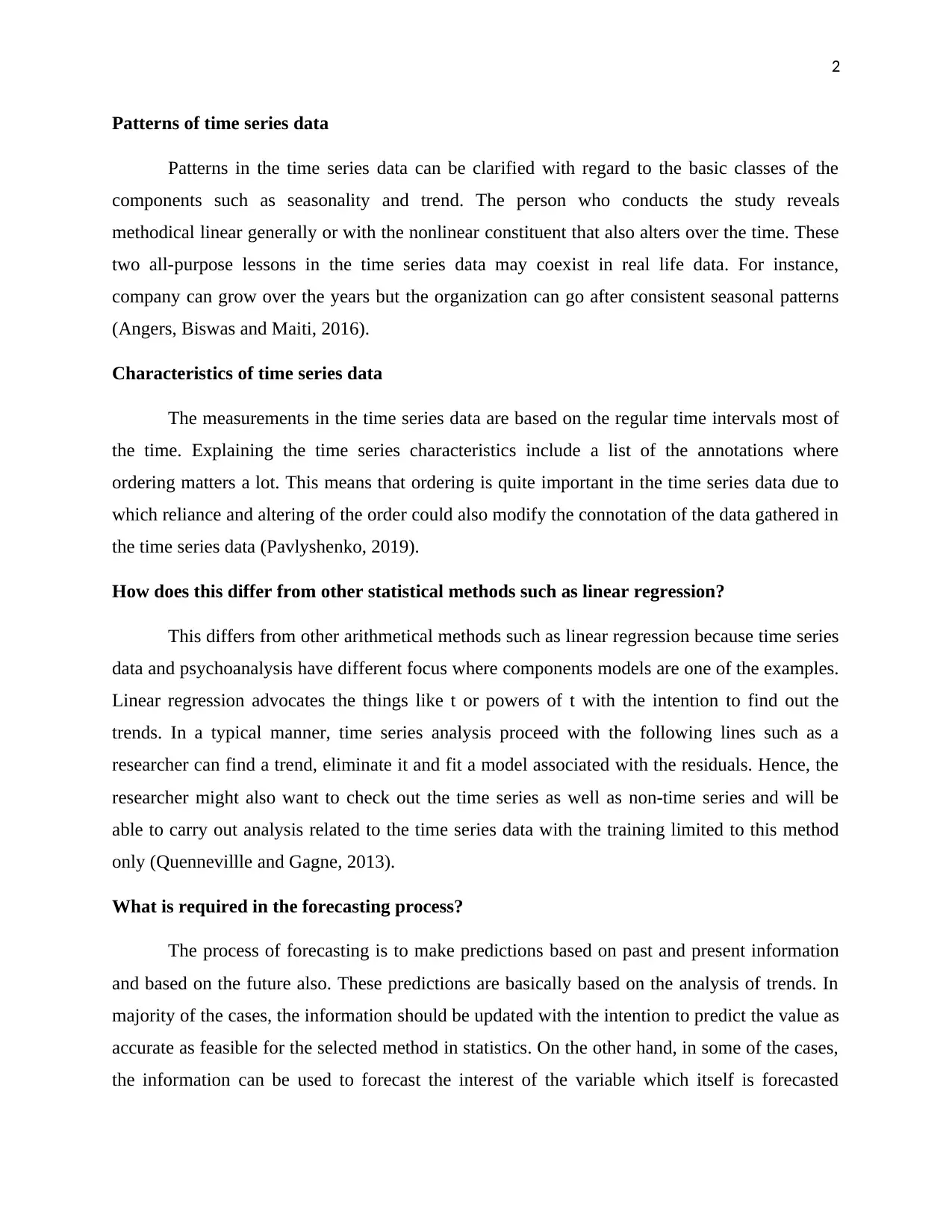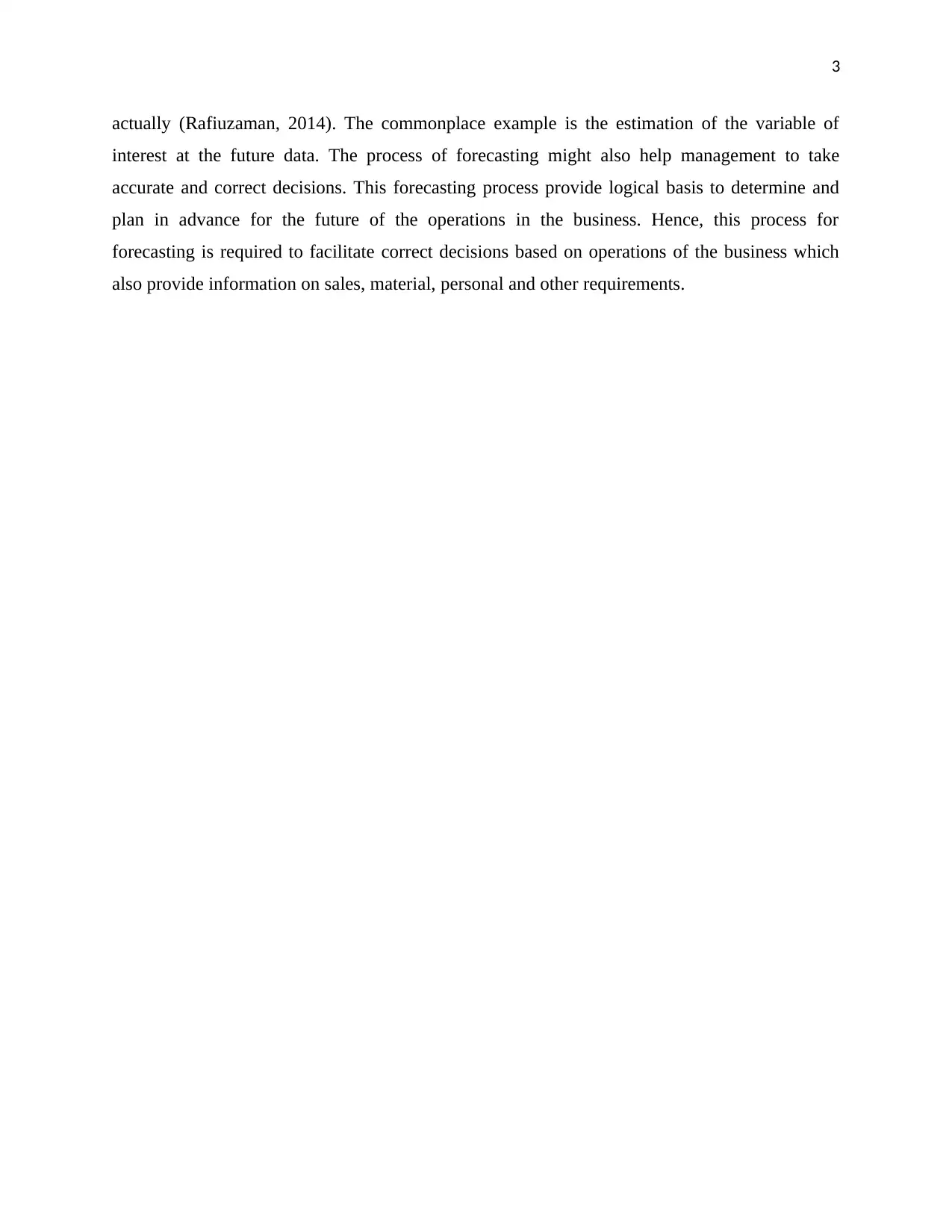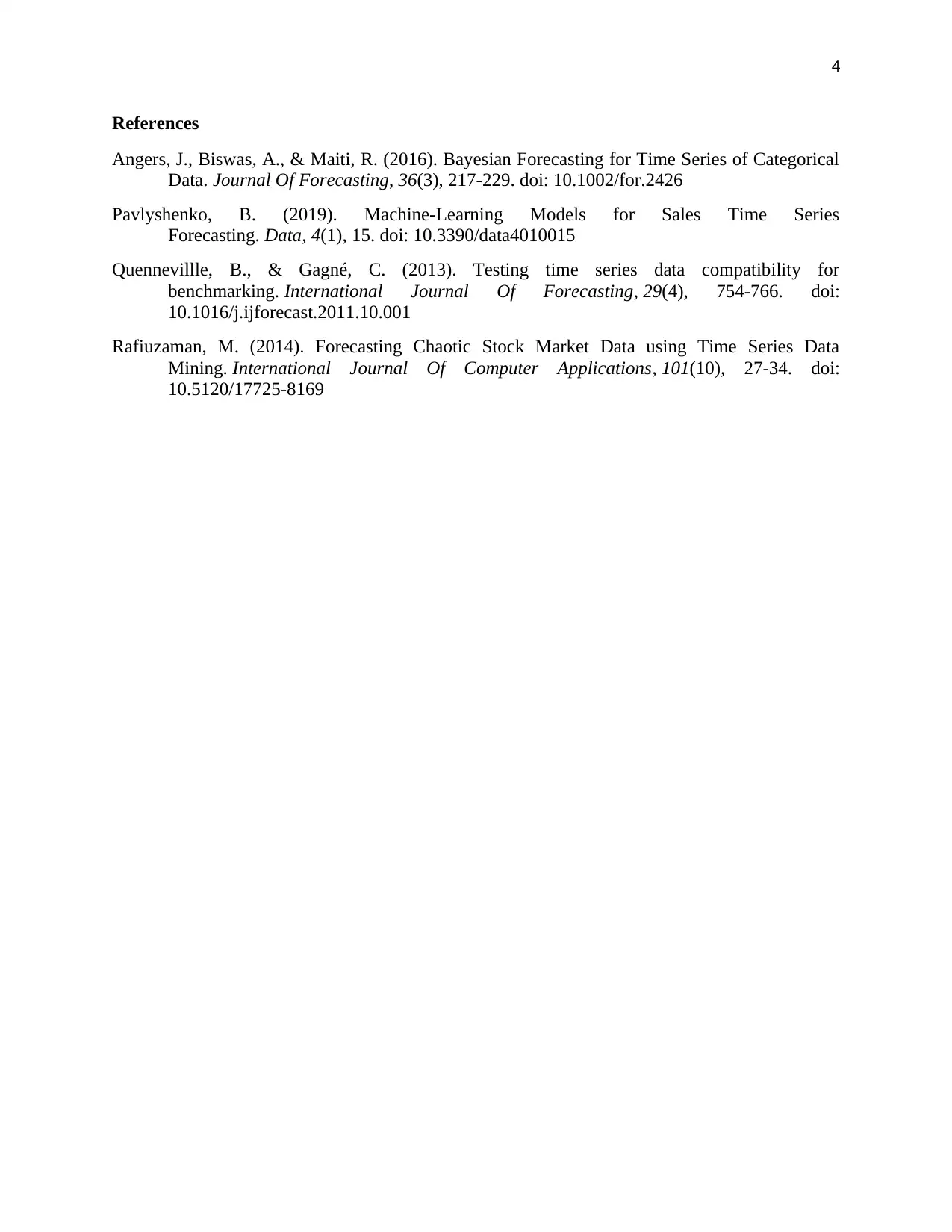Analyzing Time Series Data: Patterns, Characteristics and Forecasting
VerifiedAdded on 2023/03/31
|4
|562
|453
Essay
AI Summary
This essay provides a detailed analysis of time series data, focusing on identifying patterns such as seasonality and trends. It explores the unique characteristics of time series data, emphasizing the importance of ordering and its differences from other statistical methods like linear regression. The essay also elucidates the forecasting process, highlighting its reliance on past and present information to make future predictions and its significance in managerial decision-making. References to various research articles support the discussion, providing a comprehensive overview of time series data analysis and its applications.

Running Head: Time Series Data
Time series data
[Name of Student]
[Name of Institute]
Time series data
[Name of Student]
[Name of Institute]
Paraphrase This Document
Need a fresh take? Get an instant paraphrase of this document with our AI Paraphraser

2
Patterns of time series data
Patterns in the time series data can be clarified with regard to the basic classes of the
components such as seasonality and trend. The person who conducts the study reveals
methodical linear generally or with the nonlinear constituent that also alters over the time. These
two all-purpose lessons in the time series data may coexist in real life data. For instance,
company can grow over the years but the organization can go after consistent seasonal patterns
(Angers, Biswas and Maiti, 2016).
Characteristics of time series data
The measurements in the time series data are based on the regular time intervals most of
the time. Explaining the time series characteristics include a list of the annotations where
ordering matters a lot. This means that ordering is quite important in the time series data due to
which reliance and altering of the order could also modify the connotation of the data gathered in
the time series data (Pavlyshenko, 2019).
How does this differ from other statistical methods such as linear regression?
This differs from other arithmetical methods such as linear regression because time series
data and psychoanalysis have different focus where components models are one of the examples.
Linear regression advocates the things like t or powers of t with the intention to find out the
trends. In a typical manner, time series analysis proceed with the following lines such as a
researcher can find a trend, eliminate it and fit a model associated with the residuals. Hence, the
researcher might also want to check out the time series as well as non-time series and will be
able to carry out analysis related to the time series data with the training limited to this method
only (Quennevillle and Gagne, 2013).
What is required in the forecasting process?
The process of forecasting is to make predictions based on past and present information
and based on the future also. These predictions are basically based on the analysis of trends. In
majority of the cases, the information should be updated with the intention to predict the value as
accurate as feasible for the selected method in statistics. On the other hand, in some of the cases,
the information can be used to forecast the interest of the variable which itself is forecasted
Patterns of time series data
Patterns in the time series data can be clarified with regard to the basic classes of the
components such as seasonality and trend. The person who conducts the study reveals
methodical linear generally or with the nonlinear constituent that also alters over the time. These
two all-purpose lessons in the time series data may coexist in real life data. For instance,
company can grow over the years but the organization can go after consistent seasonal patterns
(Angers, Biswas and Maiti, 2016).
Characteristics of time series data
The measurements in the time series data are based on the regular time intervals most of
the time. Explaining the time series characteristics include a list of the annotations where
ordering matters a lot. This means that ordering is quite important in the time series data due to
which reliance and altering of the order could also modify the connotation of the data gathered in
the time series data (Pavlyshenko, 2019).
How does this differ from other statistical methods such as linear regression?
This differs from other arithmetical methods such as linear regression because time series
data and psychoanalysis have different focus where components models are one of the examples.
Linear regression advocates the things like t or powers of t with the intention to find out the
trends. In a typical manner, time series analysis proceed with the following lines such as a
researcher can find a trend, eliminate it and fit a model associated with the residuals. Hence, the
researcher might also want to check out the time series as well as non-time series and will be
able to carry out analysis related to the time series data with the training limited to this method
only (Quennevillle and Gagne, 2013).
What is required in the forecasting process?
The process of forecasting is to make predictions based on past and present information
and based on the future also. These predictions are basically based on the analysis of trends. In
majority of the cases, the information should be updated with the intention to predict the value as
accurate as feasible for the selected method in statistics. On the other hand, in some of the cases,
the information can be used to forecast the interest of the variable which itself is forecasted

3
actually (Rafiuzaman, 2014). The commonplace example is the estimation of the variable of
interest at the future data. The process of forecasting might also help management to take
accurate and correct decisions. This forecasting process provide logical basis to determine and
plan in advance for the future of the operations in the business. Hence, this process for
forecasting is required to facilitate correct decisions based on operations of the business which
also provide information on sales, material, personal and other requirements.
actually (Rafiuzaman, 2014). The commonplace example is the estimation of the variable of
interest at the future data. The process of forecasting might also help management to take
accurate and correct decisions. This forecasting process provide logical basis to determine and
plan in advance for the future of the operations in the business. Hence, this process for
forecasting is required to facilitate correct decisions based on operations of the business which
also provide information on sales, material, personal and other requirements.
⊘ This is a preview!⊘
Do you want full access?
Subscribe today to unlock all pages.

Trusted by 1+ million students worldwide

4
References
Angers, J., Biswas, A., & Maiti, R. (2016). Bayesian Forecasting for Time Series of Categorical
Data. Journal Of Forecasting, 36(3), 217-229. doi: 10.1002/for.2426
Pavlyshenko, B. (2019). Machine-Learning Models for Sales Time Series
Forecasting. Data, 4(1), 15. doi: 10.3390/data4010015
Quennevillle, B., & Gagné, C. (2013). Testing time series data compatibility for
benchmarking. International Journal Of Forecasting, 29(4), 754-766. doi:
10.1016/j.ijforecast.2011.10.001
Rafiuzaman, M. (2014). Forecasting Chaotic Stock Market Data using Time Series Data
Mining. International Journal Of Computer Applications, 101(10), 27-34. doi:
10.5120/17725-8169
References
Angers, J., Biswas, A., & Maiti, R. (2016). Bayesian Forecasting for Time Series of Categorical
Data. Journal Of Forecasting, 36(3), 217-229. doi: 10.1002/for.2426
Pavlyshenko, B. (2019). Machine-Learning Models for Sales Time Series
Forecasting. Data, 4(1), 15. doi: 10.3390/data4010015
Quennevillle, B., & Gagné, C. (2013). Testing time series data compatibility for
benchmarking. International Journal Of Forecasting, 29(4), 754-766. doi:
10.1016/j.ijforecast.2011.10.001
Rafiuzaman, M. (2014). Forecasting Chaotic Stock Market Data using Time Series Data
Mining. International Journal Of Computer Applications, 101(10), 27-34. doi:
10.5120/17725-8169
1 out of 4
Related Documents
Your All-in-One AI-Powered Toolkit for Academic Success.
+13062052269
info@desklib.com
Available 24*7 on WhatsApp / Email
![[object Object]](/_next/static/media/star-bottom.7253800d.svg)
Unlock your academic potential
Copyright © 2020–2025 A2Z Services. All Rights Reserved. Developed and managed by ZUCOL.




